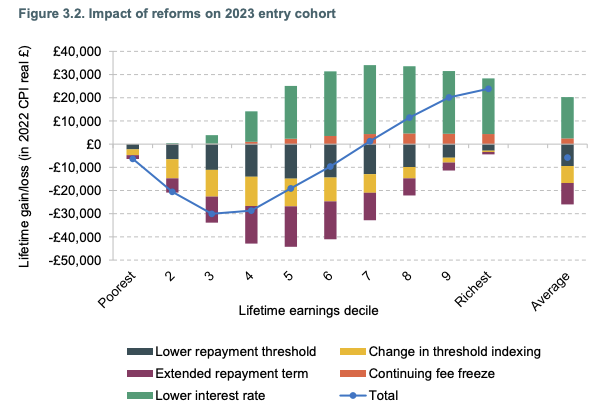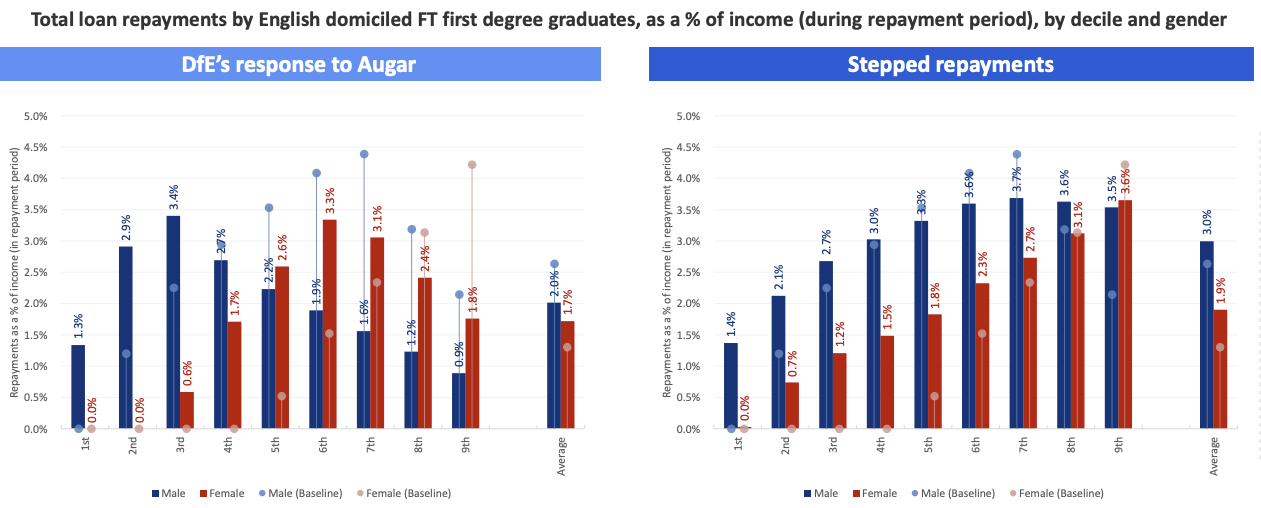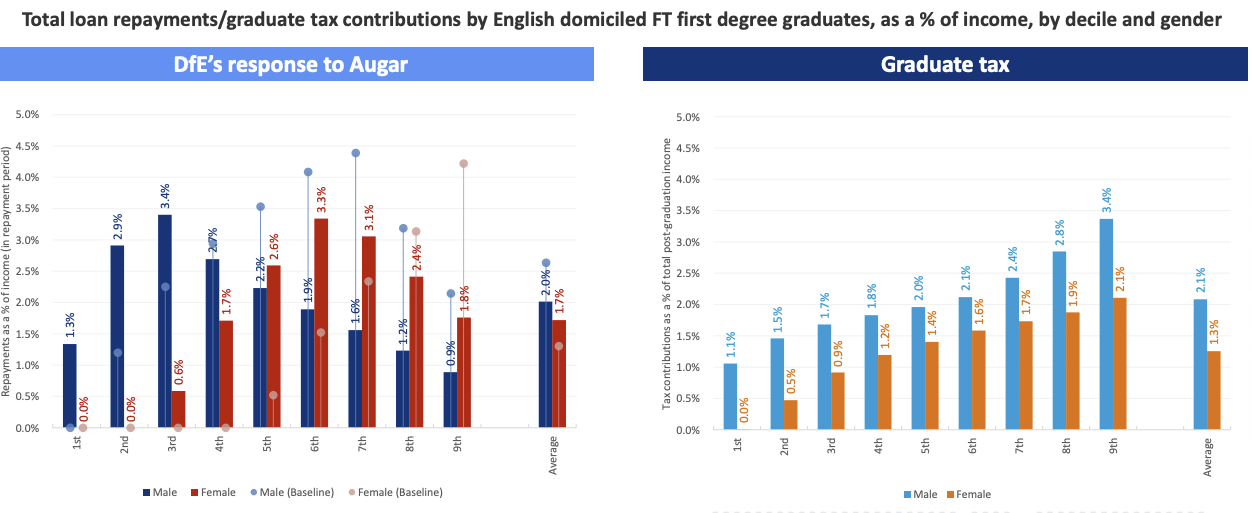If you were a leader of the opposition that wanted to drop your predecessor’s expensive-sounding “no tuition fees” pledge, you’d need a sweetener to neutralise at least a bit of the anger and disappointment that will head your way when you make the speech.
Both pre- and especially during a cost of living crisis, the sugar that Keir Starmer would want to announce would almost certainly be the totemic return of the maintenance grant. People don’t like debt, the abolition of the grant was something done by the government you’re trying to replace, and it just sort of sounds right.
Landing into Starmer’s lap is a run at doing just that. The University of the Arts London, led by Blair & Brown-era former minister turned vice chancellor James Purnell, has commissioned London Economics to produce new modelling on alternative approaches to fees and funding – and the result is two cost neutral options that illustrate potential ways forward for England’s beleaguered system of income-contingent tuition and maintenance loans.
Taking down Donelan
The first option is a set of tweaks designed to tackle the regressive nature of the reforms slipped through by Michelle Donelan earlier this year. As a reminder, as of September 2024, the repayment term for new borrowers will extend to 40 years, the repayment threshold is frozen and so reduced in real terms for a while before then uprating for inflation, and “real” interest will go, with borrowers only seeing their balance increase by inflation. The core £9,250 is also frozen for a while, and the extent to which maintenance will be uprated for actual inflation remains uncertain.

Whatever you think about that package, it’s undeniably regressive – both London Economics and the IFS have pointed out its impact on graduates in different earnings deciles which also differs by gender. So Option A instead proposes:
- A stepped repayment system of 3 per cent on earnings between £12,570 and £27,570; 6 per cent on earnings between £27,571 and £57,570, and 3 per cent on earnings of £57,571 or more;
- An increase in real interest rates post-graduation to 0%-5% for earnings between £27,571 and £57,570;
- An increase in the repayment period by 1 year.

The idea is specifically structured to ensure that even the highest earning graduates continue making repayments until the end of the repayment period – and as a result, the increased repayments of the highest earning graduates subsidise low/middle-income graduates, making the system more progressive.
What it doesn’t do, of course, is deal with phenomena of prepayment and/or overpayment from the highest earning graduates. Enter our old friend, the graduate tax.
The tax is back
Here London Economics has modelled a full replacement of current maintenance loans and fee loans with maintenance grants and fee grants with the following features:
- Thresholds mirroring current income tax thresholds, and payable until retirement (aged 65)
- A graduate tax of 3.0% on earnings between £12,570 and £50,270, and 5.5% on earnings of £50,271 or more.
- Compared to lifetime loan repayments under the Donelan response to Augar, average graduate tax contributions would be £11,100 higher for men, but £8,400 lower for female graduates.
- And because there is no notional fee or any fee and maintenance loans (or accumulated debt), there is no means of either prepayment or overpayment by affluent graduates aiming to avoid future tax obligations.

There’s a lot more detail in the deck on assumptions and implications, but at the headline level you can see how a promise to at least interrogate abolishing fees (and debt) and reintroducing grants via the introduction of a (more) progressive graduate tax could work for the Labour manifesto, with the Conservatives sticking instead to their lines on freezing fees and reducing what look like weirdly high interest rates.
All interesting stuff – but the big question is whether the intervention moves the debate on or leaves it stuck in the past.
Cross-party favours
In what some would see as an ideal world, when a present funding model for higher education runs out of steam, you would get a cross-party commission (albeit with some differences in emphases on objectives) to interrogate and neutralise the issue ahead of the election. That was essentially the position with Dearing in the mid-00s, and with Browne in the late 10s. But no such commission is on the cards – and it’s not at all clear that modelling of this sort or even a group of vice chancellors holding some round tables will hit the same sort of spot.
More significantly, while the modelling here does address the progressivity problems inherent in the DfE/Donelan confection, it doesn’t deal with the basic inadequacy of the unit of resource either on teaching or maintenance. We almost certainly need a run at establishing how much money both universities and students need outside of the confines of the failure of the fee or the maintenance loan to keep pace with inflation – and what would inevitably need to be large increases to both would be tough for either party to endorse with everything else happening in the cost of living crisis and economy right now.
This isn’t London Economics’ fault – but what the modelling also doesn’t do is address whether the “right” number of students are studying the right things, in the right way, in the right locations. A decade of letting the market decide such things has resulted in quite a bit of dissatisfaction with where things have ended up from multiple perspectives – improving information doesn’t seem to have much impact on choice, being place-blind is having all sorts of unintended impacts on communities, provider and subject sustainability for those that can’t move is threatened beyond the benefits of student choice for those that can, and governments are left with endless balloon floating of impractical “minimums” (either on outcomes or entry grades) as a way of avoiding doing what is surely inevitable – swinging back towards a bit of planning.
The launch event for the modelling tended to focus on the downsides to graduate tax, but there are also major downsides to the fees and loans “baby” that any incoming government would be wise to address. The problem always was that the £9k regime had a subsidy that students would only feel in 27 years or so if they ended up economically unsuccessful – not a great sell on the doorstep. And the problem of the principal “feeling” like real debt can never disappear as long as it’s debt and fees that the basic components that dictate how long you chip in for – and those that argue that graduates shouldn’t worry about the figure in the bottom right hand corner tend to go silent when we are reminded that the government can (and often does) change the repayment terms at will – and rarely in a positive way.
Probably the biggest issue of all is the graduation context that any proposals for change now emerge in. What Option A does is swap, at least in part, paying in one’s 50s for more graduates paying something in their 20s. That might end up being progressive overall, but with the housing market the way it is and a decade of governing largely against the economic interests of the young, the sense of intergenerational injustice that either proposal could generate may well render their political benefits as insignificant.
It’s bigger than us
Where that gets you to is a need for much bigger and divergent thinking – but at the launch event for the work hosted by HEPI, speakers tended to play the part allocated to them as if we were debating the future of higher education funding the last couple of times a graduate tax has been floated – boxing in the debate, rather than opening it up.
Former universities minister David Willetts was at pains to remind us that a graduate tax would rob universities of autonomy; Lorraine Dearden (Chair of Economics and Social Statistics at UCL) argued a grad tax would be badly targeted and risk long-term funding to universities; and having spent the day before launching a “big” conversation on fees and funding, Universities UK CEO Vivienne Stern took the opportunity to quickly narrow its terms of reference by framing the radicalism of a graduate tax in baby/bathwater and “nobody else has done this” terms.
Taken together, that might all be enough for a kind of consensus to emerge that influences Labour away from an explicit commitment on graduate tax and towards something less ambitious – perhaps a straight swap of some maintenance debt for maintenance grant (the poorest students are least likely to pay it back anyway, so doing so is almost fiscally neutral).
But if that’s where we end up, we’ll still have all the problems of unplanned, marketised massification without the resources to fund it, and all the downsides to defend. The next government will need to do better than that.












